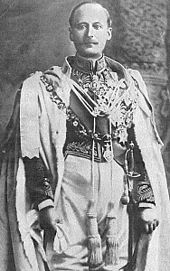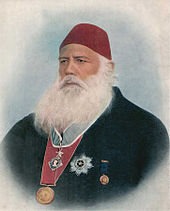Order of the Star of India


The Most Exalted Order of the Star of India is a British order of knights founded by Queen Victoria in 1861 .
Membership in the Order has not been granted since independence from India and Pakistan in 1947, but it still exists. The only remaining member is Queen Elizabeth II as sovereign of the order. The order ranks fifth of the ten British knightly orders, its motto is Heaven's light our guide (German: The light of heaven guides us).
The order was established to honor Indian rulers and high-ranking officials in the British administration in India. Some Indian states were so important that their rulers were almost automatically awarded the highest order class (e.g. the Nizams of Hyderabad and the Maharajas of Mysore ).
Order structure
The order is headed by the sovereign of the order (the respective British monarch) and the order-grand master ( grand master ; by virtue of his office always the viceroy of India ).
When it was founded in 1861, the order had a class that was limited to 25 people:
- Knight Companion (KSI).
In 1866 the order was restructured into the following three classes:
- Knight Grand Commander (GCSI), limited to 25 people;
- Knight Commander (KCSI), limited to 50 people;
- Companion (CSI), limited to 100 people.
The Knights Companion, who were still alive at the time, were promoted to Knights Grand Commander on May 24, 1866.
Deviating from the usual designations for British orders, the highest class was not referred to as the Knight Grand Cross in order to improve the acceptance of the order among non-Christian Indians.
In particular , Indian princes ruling under British sovereignty were appointed to the order, including princesses in their own right. Unlike in other orders, these were then not referred to as "Lady", but, like the men, as "Knight".
Ceremonial clothing and regalia
On important occasions, such as the coronation of British monarchs , the members of the Order wore their own ceremonial attire, which was dependent on the class:
- The cloak was only worn by the Knights Grand Commander. It was made of light blue satin framed with white silk. The breast star (see below) was worn on the left.
- The collane , also worn only by Knights Grand Commander, was made of gold. Its limbs were alternately designed as lotus blossoms, red and white roses and palm branches, each with the Imperial State Crown in the middle.
Simpler insignia were used on less important occasions:
- The breast star was only worn by the Knights Grand Commander and the Knights Commander on the left chest. It showed alternating 26 large and 26 smaller rays. The Knights Grand Commander star was gold and circular; the Knights Commander star was silver and eight-pointed. In the center of the star was a blue ribbon in which the motto of the order was reproduced. At the center of this ribbon was a five-pointed star that was set with diamonds at Knights Grand Commander .
- The medal was the only one worn by all members of the order. It was worn on a light blue ribbon with white edges. Knights Grand Commander wore the medal on a sash that was carried over the right shoulder to the left hip. Knight Commander and Companions wore it on the ribbon as a neck medal . The medallion itself was an oval medallion with the image of the sovereign surrounded by the ribbon described above with the motto of the order. The medallion was connected to the ribbon by a five-pointed star, which was also set with diamonds in the Knights Grand Commander.
In contrast to the majority of British knightly orders, the insignia deliberately did not use the Christian symbol of the cross in order to facilitate the acceptance of the order among Indian non-Christians.
Hierarchy and privileges
The members of the order had a position in the protocol Aryan ranking in the UK ( Order of Precedence ), a list in which the registered persons are classified according to their nominal significance and plays an important role in ceremonial events. Wives of male members were also accepted there; so are the sons, daughters and daughters-in-law of Knights Grand Commander and Knights Commander. In contrast, relatives of a female member were not included in the list.
With the elevation to Knight Companion , Knight Grand Commander and Knight Commander , the knighthood and thus the elevation to the personal nobility was connected for subjects of the sovereign and with it the authority to use the predicate " Sir " before their first name; female Knights Grand Commander and the Knights Commander as well as the wives of Knights Grand Commander and Knights Commander were allowed to use the predicate "Lady" in front of their names; no comparable privilege existed for the husbands of the female knights. Instead of these predicates, many knights of the order carried the predicates associated with their higher nobility titles. If foreigners were accepted into the order who were not subjects of the sovereign, the acceptance was on an honorary basis (as Honorary Knight Grand Commander or Honorary Knight Commander ) and was not associated with a nobility.
All order members are or were entitled, depending on their order class, to add the letters KSI , GCSI , KCSI or CSI as post-nominal .
Knights Grand Commander were authorized to include shield holders in their coat of arms . They were also allowed to include a circlet showing the order's motto and an image of the collar in their coat of arms. Knights Commander and Companions were only allowed to show the bracelet in their coat of arms, but not the chain of the order.
Well-known medal bearers
- Arthur, Duke of Connaught and Strathearn , GCSI
- Sir Joseph Dalton Hooker , GCSI
- Louis Mountbatten, 1st Earl Mountbatten of Burma , GCSI
- Frederick Roberts, 1st Earl Roberts , GCSI
- Sir Ganga Singh , 21st Maharajah of Bikaner , GCSI
- Archibald Wavell, 1st Earl Wavell , GCSI
- Ahmad al-Jabir al-Sabah , KCSI
- Colin Campbell, 1st Baron Clyde , KSI
- Harold Alexander, 1st Earl Alexander of Tunis , CSI
- Sir Claude Auchinleck , CSI
- Sir Albert Abdullah David Sassoon , CSI
- Jagadish Chandra Bose , CSI
- Lionel Dunsterville , CSI
Literature and web links
- William Arthur Shaw: The Knights of England. Volume 1, Sherratt and Hughes, London 1906, pp. Xxv f.
Individual evidence
- ↑ a b The London Gazette : No. 22523, p. 2621 , June 25, 1861.
- ^ The London Gazette: 23119, 3128 , May 25, 1866.


